In the fishing world, there is an almost overwhelming amount of knots! Of all the fishing knots out there, however, none are as versatile and effective as the uni knot. The uni knot works with many different types of lines, different amounts of lines, and different types of connections. Let's tell you all about it!
What Is The Uni Knot?
The uni knot is commonly known as the Grinner Knot or Duncan loop in British English. The knot was first published in 1944 under the name Gallows knot in The Ashley Book of Knots. The knot was also called Duncan loop years ago, named after Norman Duncan, who developed it in the early 1960s and was popularized by a Miami Herald, Vic Dunaway, in a 1970s fishing book "Baits, Rigs & Tackle."
The uni knot is considered the "most useful fishing knot" for a good reason. You can use it to tie directly onto hooks and lures or connect two lines. And it works on many different types of lines! Rather than committing a long list of fishing knots to memory, you can learn this single knot and be prepared to handle just about any issue that comes up while out fishing!
The uni knot is the perfect knot to teach children or beginning anglers. With this single knot, they can put together entire leader assemblies. It's a great knot to use for building confidence and experience!
There are two variations of the uni knot: the traditional uni knot and the double uni knot. Let's take a look at both.
Uni Knot
The standard uni knot is used for tying a mainline to hooks or lures. It's one of the most popular knots for this connection, as it's quick to tie and has a high breaking strength. You can also use it with a wide variety of types and sizes of fishing lines! Admittedly, it's not as strong as the Palomar Knot and is bulkier than other line-to-hook/lure knot options.
Double Uni Knot
If you're a saltwater angler, you know that the most important knot on your whole rig is the line-to-line knot that connects your fishing leader to the main line. It's a tricky connection because the two lines are typically very different from each other. The reel line is as light as possible to improve casting, while your leading fishing line needs to be heavy. Saltwater fish have sharp mouths that will snap right through anything less! Your line-to-line knot can be the weak length of your system.
The double uni knot is the perfect fishing knot for this connection. It's quick to tie, has a high breaking strength, and can be used with any combination of lines. However, it is bulkier and not quite as strong as the FG knot - another popular choice for this connection!
How To Tie A Uni Knot
Here's how to tie a standard, traditional uni knot, connecting the main line to the loop of a hook, swivel, or lure.
1. Thread the line through the eye of your hook or lure.
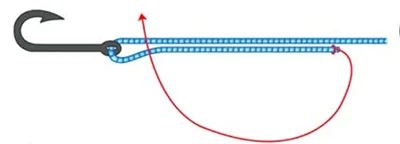
2. Bring a good 8 inches of the working end through the lure and up over the main line or standing line. Pinch the two lines together above the hook eye.
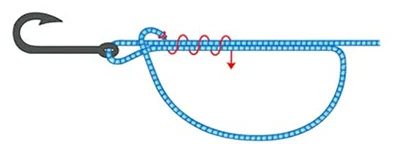
3. Curve the working tag end around, forming a small loop in front of the double line. Leave the tag end pointing upwards.

4. Wrap the tag end around the doubled lines multiple times, making sure to go through the loop with each pass. Keep wrapping until you've nearly used up your tag end!
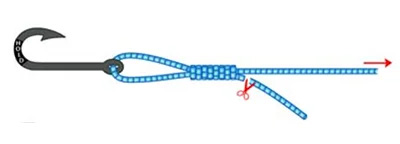
5. Pull on the tag end finger tight - this tightens the knot.
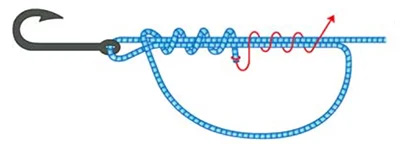
6. Pull the mainline until the knot slides down against the eye of the hook or lure - this locks the knot into place. Trim off excess end.
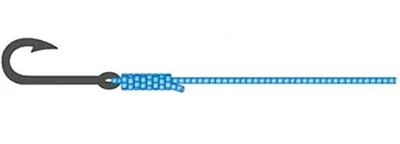
How To Tie A Double Uni Knot
Here's how to tie a double uni knot - one of the best knots for tying two lines together, particularly if the lines are of different types!
- Overlap the leader line, and the mainline with the tag ends going in opposite directions.
- Using your left hand, grab the midpoint of the overlapped lines.
- Create a loop in the monofilament line, with the tag end of the line pointing up.
- Wrap the monofilament leader tag end around the doubled line along the top of the loop, making sure to go through the loop and around both lines with each pass. Keep wrapping until you've nearly used up your tag end - at least five times.
- Pull on the leader lines to tighten the knot.
- Hold the tightened knot with your right hand, then form a loop with your thinner line so that its tag end points up.
- Wrap the braided mainline tag end around the doubled line along the top of the loop. Wrap as many times as possible. If you're using a braided line, wrap it at least ten times!
- Pull on the mainline ends to tighten the knot.
- You now have two coiled uni knots, one made from each line. Let go of the two tag ends and pull on the lines until the knots slide together, joining in the middle. Trim off the ends.
Adjustments For Tying A Uni Knot With Braided Line
A braided fishing line is a very slick line, and every knot requires some adjustments when using it to maximize knot strength. Here's what you need to adjust when using a braided line for uni knots.
- Go through the eye of your hook twice when first attaching the line. This will keep your hook from slipping around in your knot.
- Give yourself more than 8 inches of a tagline, so you have more lines to work with when wrapping around your loop. Eight inches is good.
- Wrap the tag end of the braided line a full 10 to 12 times around the doubled lines.
Now that you know how to tie a Uni Knot and are looking to tie an even stronger line, there are several knots you can use to link a fishing line to your main line. Some prefer using the Blood Knot, and some like using the J Knot.
